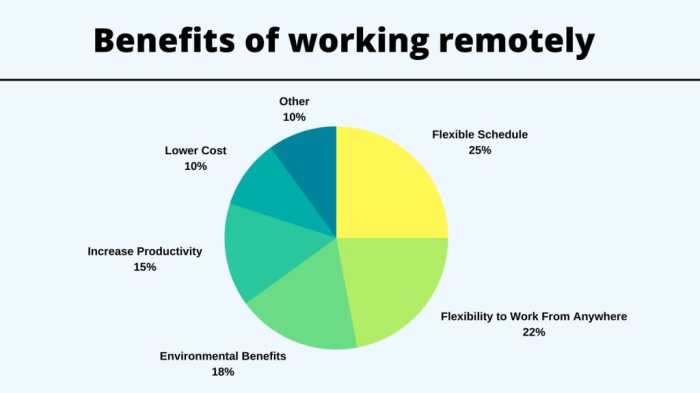Remote Work Productivity: As the buzz around remote work productivity grows louder, dive into a world where efficiency and success go hand in hand in the digital age.
In today’s fast-paced work landscape, the ability to excel in a remote setting is crucial for both individuals and organizations alike.
Introduction to Remote Work Productivity
Remote work productivity refers to the ability of individuals to effectively and efficiently complete tasks, meet goals, and deliver results while working from a location outside of a traditional office setting. In today’s modern work environments, remote work has become increasingly common, with more companies embracing flexible work arrangements to accommodate the changing needs of their employees.
The importance of remote work productivity cannot be overstated, as it directly impacts both individuals and organizations. For individuals, remote work productivity allows for a better work-life balance, increased flexibility, and reduced commuting time, leading to higher job satisfaction and overall well-being. On the other hand, for organizations, remote work productivity can result in cost savings, improved employee retention, and increased productivity levels.
Impact of Remote Work Productivity on Business Outcomes
- According to a study by Global Workplace Analytics, businesses that allow remote work experience a 25% increase in employee productivity.
- Research conducted by Stanford University found that remote workers are 13% more productive compared to their in-office counterparts.
- A case study of a Fortune 500 company showed a 22% increase in revenue after implementing remote work policies that focused on enhancing productivity.
Factors Influencing Remote Work Productivity
Remote work productivity is influenced by several key factors that can either enhance or hinder an individual’s performance. Technology, work-life balance, and communication are crucial aspects that play a significant role in determining the productivity levels of remote workers.
Technology in Remote Work
Technology is a driving force behind remote work productivity. With the advancement of communication tools, project management software, and collaboration platforms, remote workers can easily connect with team members, access necessary information, and efficiently complete tasks. The seamless integration of technology in remote work enables individuals to stay organized, track progress, and communicate effectively with colleagues, ultimately boosting productivity.
Work-Life Balance Impact
Maintaining a healthy work-life balance is vital for remote work productivity. Without a clear boundary between work and personal life, individuals may struggle to focus, experience burnout, and have difficulty disconnecting from work-related stress. Establishing a routine, setting boundaries, and prioritizing self-care are essential practices that can positively impact productivity levels and overall well-being in a remote work environment.
Strategies for Improving Remote Work Productivity

To enhance your remote work productivity, it’s crucial to set up a conducive work environment, manage your time effectively, and stay focused to avoid distractions.
Setting Up an Effective Remote Work Environment
- Create a designated workspace that is comfortable and free from distractions.
- Ensure you have all the necessary tools and equipment, such as a reliable internet connection and a comfortable chair.
- Add personal touches to make the space inspiring and motivating, like plants or artwork.
Time Management Techniques for Boosting Productivity
- Set specific work hours and stick to a routine to create structure in your day.
- Use time tracking tools to monitor how you spend your time and identify areas for improvement.
- Break down tasks into smaller chunks and prioritize them based on importance and deadlines.
Best Practices for Staying Focused and Avoiding Distractions
- Minimize distractions by turning off notifications on your phone and computer during focused work sessions.
- Use the Pomodoro Technique to work in focused intervals with short breaks in between.
- Communicate clear boundaries with family members or roommates to minimize interruptions during work hours.
Tools and Technologies for Remote Work Productivity

In today’s remote work environment, having the right tools and technologies is essential for staying productive and efficient.
Essential Tools and Software
- Video Conferencing Platforms: Tools like Zoom, Microsoft Teams, and Google Meet are crucial for virtual meetings, collaboration, and team communication.
- Project Management Software: Platforms such as Trello, Asana, and Jira help remote teams organize tasks, set deadlines, and track progress.
- Communication Apps: Slack, Microsoft Teams, and Skype facilitate real-time messaging, file sharing, and team collaboration.
- Cloud Storage Services: Dropbox, Google Drive, and OneDrive enable secure storage, access, and sharing of files from anywhere.
Comparison of Project Management Tools
- Trello: Known for its user-friendly interface and visual boards, ideal for small teams and simple projects.
- Asana: Offers robust task management features, suitable for larger teams and complex projects with multiple dependencies.
- Jira: Designed for software development teams, with advanced issue tracking, agile project management, and integration capabilities.
Collaboration Platforms for Enhanced Communication
- Slack: Facilitates instant messaging, file sharing, and integration with other tools for seamless communication.
- Microsoft Teams: Combines chat, video meetings, file storage, and app integration within a single platform for comprehensive collaboration.
- Google Workspace: Enables real-time collaboration on documents, spreadsheets, and presentations, promoting teamwork and productivity.






